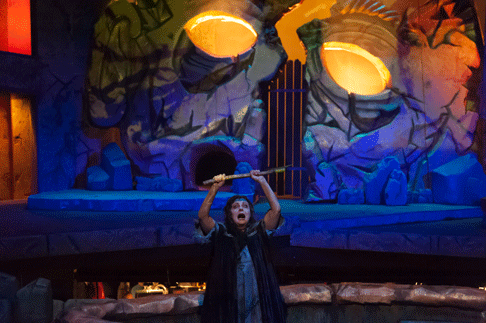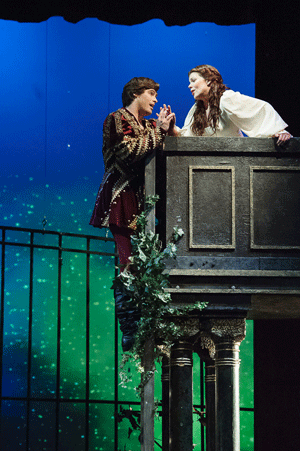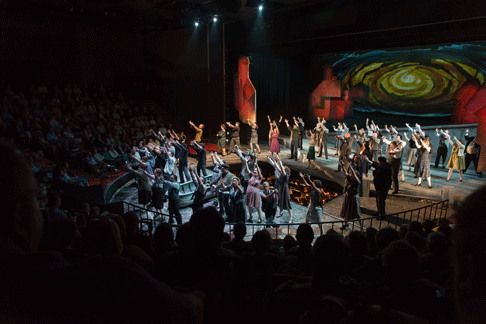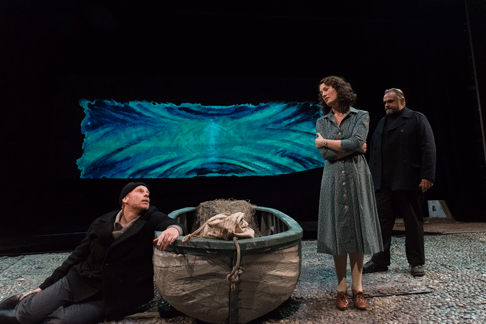Long considered a jewel of the Midwest, the enterprising company seemed
determined to break out of regional status with a world-class production of
Elektra.
Everything about this Strauss one-acter was first rate, starting and ending
with the polished sweep of a firing-on-all-cylinders orchestra that embraced
its full partnership in the drama. To document merely a few of their
extraordinary moments, witness the unearthly skittering of strings as we
awaited the two off-stage executions; the snarling, sneering brass that
underscored the characters’ deadly mental instabilities; and especially, the
impeccable winds (both in solo and ensemble) performing as knowing commentators
in the unfolding plot.
Conductor David Neely shaped the piece superbly and elicited virtuosic
playing from his excellent instrumentalists. This was a reading fully invested
with the psychological import, musical colors, and emotional content that mark
the greatest performances. Maestro Neely carefully balanced this towering
achievement in the pit with his sensational cast of vocalists.
If Brenda Harris does not yet ‘own’ the title role, she will. I know of
no one singing Elektra today that is performing it this well. Ms. Harris has a
full-bodied soprano that ‘speaks’ in all registers and at all volume
levels. The top has a laser-beam intensity and pinpoint accuracy that rides the
orchestra without strain. Her tossed off comments and bitchy asides were
equally present. And owing to her solid technique, Brenda sounds as fresh at
the end of the night’s challenges as she was at the start. Today’s
‘Elektra of Choice’ has arrived.
Julie Makerov’s Chrysothemis perfectly complements and contrasts our
Elektra, showcasing a perfectly round, warm, youthful tone. Ms. Makerov, too,
has a commanding instrument that soars above the band with ease. There are rare
moments when she presses a little harder then needed and some releases of
sustained high notes thereby go a little wild, but hers was a solid
achievement.
Joyce Castle commands the stage as Klytemn‰stra, deploying a voice with a
freshness and poise that belies her age. After forty years, Ms. Castle still
boasts one of the finest mezzos in the business, with a reliable upper register
of polished bronze that retains its richness all the way down into a well-knit
baritonal chest voice. Moreover, Joyce proved yet again that she is a
consummate actress as she etched a completely thought out characterization of
nuance and depth. Why beat around the bush: I have seen some heavy-hitters take
on this pivotal role over the years but Joyce Castle is as fine a Klytemn‰stra
as you will likely ever see.
I urge you to peruse the full cast list carefully since all the Maids and
the Overseer were uniformly terrific. Their well-projected and well-matched
singing was urgent, edgy, and firmly declamatory. They perfectly established
the tone of the piece in the important opening scene. Corey Bix’s frenetic
Aegisth was completely drawn and pointedly sung. As Orest, Philip Horst’s
potent baritone embodied a steady heroic stature. While all of the small roles
were well-taken by DMMO’s Apprentice Artists, David Margulis made an
especially fine impression with his clear, pleasing tenor, making the most of
his brief turn as the Young Servant.

Set Designer R. Keith Brumley filled the thrust playing space with a huge,
jarring, deconstructed face of Agamemnon. The eyes were the windows in which
the menacing assassins appear, where Aegisth begs for rescue, and where
torchbearers take residence during the Queen’s comings and goings. A
nostril-opening at stage level affords a Maid an escape route before she is
drug back declaring they are beating her. The vertical crack in the middle of
the King’s visage allows prime placement of the main palace door, and the
lips decorate a sort of cistern on the passerelle/apron of the space. It is
here that the axe is buried.
Barry Steele has devised a lighting plot of great variety and specificity.
The use of projections was effective and further supported the unsettling
shifts of the story and morphing character relationships. Melanie Taylor
Burgess’s character-specific costumes were augmented by Robin L. McGee.
Especially telling was Klytemnestra’s removal of her lavish, jewel-encrusted
cape and crown to have a girl-to-girl, down-to-earth chat with Elektra.
Director Dugg McDonough imposed great clarity on the proceedings with tight
blocking that utilized the entire playing space to fine effect. Mr. McDonough
created some excellent stage pictures to boot, like the restless pacing and
interaction of the Maids in the opening, and Orest’s re-appearance at the
ending, with Chrysothemis hovering above Elektra’s body. All points in
between were mounted with the same attention to detail and thoughtful
story-telling.
 Scene from RomÈo et Juliette
Scene from RomÈo et Juliette
The season also numbers a perfectly lovely RomÈo et Juliette among
its accomplishments. Cast from strength, lovingly conducted, and imaginatively
staged in evocative sets (adapted from Kansas City Lyric Opera’s production),
this was a near ideal combination that made a very strong case for Gounod’s
opus.
Sara Gartland’s Juliette was wondrously sung. Her big, responsive,
gleaming lyric tone proved to have plenty of ravishing sound for all the big
moments, cresting the orchestra with ease. True, like many a Juliette, Ms.
Gartland fudged the trills and passage work a bit in the tricky Je veux
vivre, but spent the rest of the night inviting comparison to the great
interpreters of the part. She scored big with a compelling account of the
potion aria, and her deeply felt final scene was the most honestly commnicated
passage of the entire piece. And Sara’s lovely, poised presence proved a
perfect fit for the young heroine. You will be hearing more from and about this
outstanding talent.
Matching her accomplishment was Jason Slayden’s idiomatic, coltish RomÈo,
characterized by glinting high notes and a beautiful tenor instrument. Mr.
Slayden cut a handsome, boyish figure and paired beautifully with his love
interest. His singing was imaginative and varied, and his interpretive skills
are wide-ranging. That said, while his top is a thing of beauty (especially in
tandem with Ms. Gartland), I am not sure it is always freely produced, the
price of the intense momentary aural pleasure being a hint of unsteadiness in
the descent, and occasional notes that were ‘just’ under the pitch. Still,
all told, for musicality, gorgeous singing and dramatic credibility, Des Moines
has fielded an impressive pair for their title roles.
Craig Verm’s strapping Mercutio threatened to dominate his every scene,
his throbbing baritone powerfully utilized to entertain us mightily with a
winning Queen Mab aria. Mr. Verm totally immerses himself in the drama which,
when things got heated up in the duel, led to his bullying a high note or two.
But this was a memorable role assumption. As Tybalt, tenor Heath Huberg was
experiencing some tightness at first, but rapidly warmed up to contribute a
propulsive confrontation with RomÈo and a touching death scene.
Sarah Larsen’s StÈphano combined good stage presence with a supple mezzo,
yielding a stylishly sung and imaginatively acted Que fais-tu, blanche
tourtourelle. Tony Dillon brought a plush cushion of a bass-baritone voice
to Capulet, although he might at times watch the rhythmic pulse of certain
phrases. Jeffrey Tucker’s solid, incisive bass served FrÈre Laurent well.
Kyle Albertson brought our full attention to the brief role of the Duke thanks
to his rolling, mellow bass sound. Character mezzo Susan Shafer added
immeasurably to the proceedings with her witty traversal of Gertrude.
Christopher Scott was effective as a securely voiced Paris.
Once past a slightly scrappy contrapuntal segment in the prelude, conductor
Kostis Protopapas settled the assembled orchestral forces for a loving,
luminous reading. The Maestro partnered the singers exceedingly well, allowing
them to shine, with the all-important duets notable for their spontaneity and
meaningful interaction. The choral work was of a high standard indeed, thanks
to Chorus Master Lisa Hasson.
R. Keith Brumley has effectively adapted Kansas City’s scenery to this
venue’s unique stage, and the simple, attractive components more than met the
requirements of all the signature moments. An especial success was having the
plinth of the tomb on the apron to start the show with a flash forward of the
lovers in lifeless repose upon it, and then to close the evening in real time
with the same imagery.
While Barry Steele’s lighting was a complete success, his video
projections were less so. With orchestra lights in my eyes, I could not read
any but the one or two very largest of the quotes that were projected on the
front scrim at the start of scenes. The gorgeous period costumes were
coordinated by Robin L. McGee. John de los Santos livened the ballroom scenes
with effective choreography that was well executed. And Brian Robertson created
some of the best stage combat ever, athletically and cleanly performed by an
enthusiastic young cast.
Director Linda Ade Brand created meaningful blocking, and fostered
relationships between her players that were believable and inevitable. A minor
quibble: Once past the effective, grief-imbued opening ‘flash forward,’
there was not always a fully committed internal life to the proceedings until
the first lovers’ duet. This is a challenge of Gounod’s writing, of course,
and the overall effect of this sincerely delivered performance was nevertheless
remarkably fine.
 Scene from Peter Grimes
Scene from Peter Grimes
Peter Grimes poses its own set of daunting challenges, which were
largely met head on by this enterprising company. Since ‘environment’ is so
all-important to the tale, let me begin by admiring set designer Brumley’s
handsome suggestion of a British fishing village. The huge, steeply raked
‘walk’ that occupied the upstage went from floor level on stage right to
what looked like ten feet high on stage left. Damn, it was steep! It was backed
by a well-textured sea drop that occasionally lowered to allow for complex
expressionistic images to be projected on the cyc above it.
Complementing this were groupings of detailed houses, a church, tavern
walls, etc. that were flow in and out as necessary. Grimes’ hut rose out of
the apron and a trap door in the hut’s floor enhanced our belief that
Apprentice two ‘fell’ to his death. Grimes’ boat also spent some time
here, as much an ominous presence as a prop. Mr. Steele once again provided
fine lighting effects that were tight, moody, and well-considered. Ms. McGee
designed costumes that enhanced and communicated the characters.
I appreciated director Kristine McIntyre’s bold, consistent choices, even
as I did not always agree with them. Ms. McIntyre chose to often stylize the
movement of the chorus and there is no denying that they executed their
assignments with admirable skill and elan. However, having three lines of
choristers lock arms around shoulders and rock from side to side like a
“sea” of humanity seemed self-conscious. Later, when there was similar
synched movement by street revelers, matched by the flown buildings
“dancing” in partnership (no kidding), well, the semaphoric gesturing began
to less resemble Britten’s opera than say, Jersey Shore: The
Musical.
Our director did display considerable success with interaction of the
principals, and almost all of them limned effective individualized portrayals.
Alas, the one that did not, was the very tragically flawed central personage
for whom the opera is named.
From the git-go, Roger Honeywell’s Grimes was too controlled, too
‘normal.’ Instead of suggesting a hint of dementia, or at least an
incomplete understanding of the import of his apprentice’s death at sea, Mr.
Honeywell seemed genuinely saddened and contrite. In an expository scene that
is designed to establish that the judgmental local populace has long had an
aversion to this fisherman who is not ‘quite right,’ we were instead
wondering how they could not feel sorry for him. An interesting angle, but one
that does not ground the drama.
The good news is that the tenor has acquitted himself very well in the vocal
department by bending the role’s challenges to his strengths. This includes
relishing his ability to hurl out savage top notes with ping and power, but not
overusing the effect. Mr. Honeywell, also melds a slightly heavy croon with a
weighted emotional delivery that mines a potent effect out of all those pesky
repeated tones in the passaggio (damn Peter Pears for having that skill!). And
Roger wisely kept his mid-range cleanly conversational and resisted the urge to
press the tone. While absolutely focused and consistent in his approach, I
would hope that he further develops his understanding of this complex character
for I think he could become a memorable Peter Grimes.
SinÈad Mulhern has a warm and full soprano with a generous vibrato that
made Ellen more womanly and assertive than is often the case. Her heartfelt,
soothingly melismatic Embroidery Aria was one of the evening’s
highpoints. Ms. Mulhern was somewhat challenged in her task by the addition of
a rather passionate kiss with Peter at the culmination of their opening duet
(The truth. . .the pity). If we are thus led to believe that the two
may have already had a physical relationship, it does make hash of other
‘usual’ subtext dealing with Grimes’ sexual ambiguity, another reason he
is shunned by the town. And it does raise questions about Ellen’s character
and motivation that become distractions.

Todd Thomas turned in a marvelous account of Balstrode, his burnished
baritone evenly produced and well modulated to the character’s vocal
portrait. Susan Shafer was a plucky, plummy Auntie, who knew how to make every
salty line count. Sara Ann Mitchell and Dana Pundt were highly effective as
Nieces 1 and 2, respectively, and their superbly controlled phrasings in the
upper register wove threads of pure silver through the quartet. Corey Bix was
suitably blustery as Bob Boles, and Jeffrey Tucker relished his turn as
Swallow.
Kathryn Day made a mighty impression as the meddling Mrs. Sedley, and she
colored her well-schooled mezzo to fine, insinuating effect. As the Reverend,
George Ross Somerville’s characterful tenor provided a nice variety. Talented
baritone Craig Verm gifted us with a notably well-sung Ned Keene, confirming my
favorable impression in the Gounod that Craig’s star should soon be on the
rise.
Ms. Hasson once again worked magic with the choral preparation so critical
to the success of this masterpiece. While I cannot say that the young
Apprentice group of hopeful soloists fully congealed like a professional opera
chorus might after years together working as an ensemble, I certainly applaud
their fine achievement.
Maestro Neely was presiding in the pit, and he drew forth a highly charged,
yet tightly controlled reading, encompassing all the drama in the score that
the staging sometimes missed. DMMO should be justly proud of a festival
orchestra that would be the envy of many a major house.
James Sohre
Production and cast information:
Elektra
Elektra: Brenda Harris; Chrysothemis: Julie Makerov; Klytemn‰stra:
Joyce Castle; Confidante: Emily Holsclaw; Trainbearer: Lindsey Anderson; Young
Servant: David Margulis; Old Servant: Brad Baron; Orest: Philip Horst; Tutor:
Tony Dillon; Aegisth: Corey Bix; Overseer: Megan Cullen; 1st Maid: Kathryn Day;
2nd Maid: Jill Phillips; 3rd Maid: Sarah Larsen; 4th Maid: Cassie Glaeser; 5th
Maid: Rebecca Krynski; Conductor: David Neely; Director: Dugg McDonough; Set
Designer: R. Keith Brumley; Costume Designer: Melanie Taylor Burgess, executed
by Seattle Opera Costume Shop; Additional Costumes: Robin L. McGee; Lighting
and Video Designer: Barry Steele; Make-Up and Hair Designer: Sarah Hatten for
Elsen and Associates, Inc.; Choreographer: Eve Summer; Stage Combat Director:
Brian Robertson
RomÈo et Juliette
Juliette: Sara Gartland; RomÈo: Jason Slayden; FrÈre Laurent:
Jeffrey Tucker; Mercutio: Craig Verm; StÈphano: Sarah Larsen; Capulet: Tony
Dillon; Tybalt: Heath Huberg; Gertrude: Susan Shafer; The Duke: Kyle Albertson;
Paris: Christopher Scott; GrÈgorio: Kenneth Stavert; Benvolio: Stefan Barner;
FrÈre John: Anthony Udrovich; Conductor: Kostis Protopapas; Director: Linda
Ade Brand; Chorus Master: Lisa Hasson; Set Designer: R. Keith Brumley (from
Lyric Opera of Kansas City); Lighting and Video Designer: Barry Steele;
Costumes: A.T. Jones and Sons, Inc., Baltimore; Costume Supervisor: Robin L.
McGee; Make-Up and Hair Designer: Sarah Hatten for Elsen and Associates, Inc.;
Choreographer: John de los Santos; Stage Combat Director: Brian
Robertson
Peter Grimes
Peter Grimes: Roger Honeywell; Boy Apprentice: Zachary Koeppen; Ellen
Orford: SinÈad Mulhern; Captain Balstrode: Todd Thomas; Auntie: Susan Shafer;
Niece 1: Sara Ann Mitchell; Niece 2: Dana Pundt; Bob Boles: Corey Bix; Swallow:
Jeffrey Tucker; Mrs. Sedley: Kathryn Day; Rev. Horace Adams: George Ross
Somerville; Ned Keene: Craig Verm; Hobson: Kyle Albertson; Dr. Crabbe: Dan
Jacobsen; Conductor David Neely; Director: Kristine McIntyre; Chorus Master:
Lisa Hasson; Set Designer: L. Keith Brumley; Costume Designer: Robin L. McGee;
Lighting and Video Designer: Barry Steele; Make-Up and Hair Designer: Sarah
Hatten for Elsen and Associates, Inc.
image=http://www.operatoday.com/Elektra-396.gif
image_description=Scene from Elektra [Photo by Jen Golay courtesy of Des Moines Metro Opera]
product=yes
product_title=Musical Fireworks in Iowa
product_by=A review by James Sohre
product_id=Above: Scene from Elektra
Photos by Jen Golay courtesy of Des Moines Metro Opera